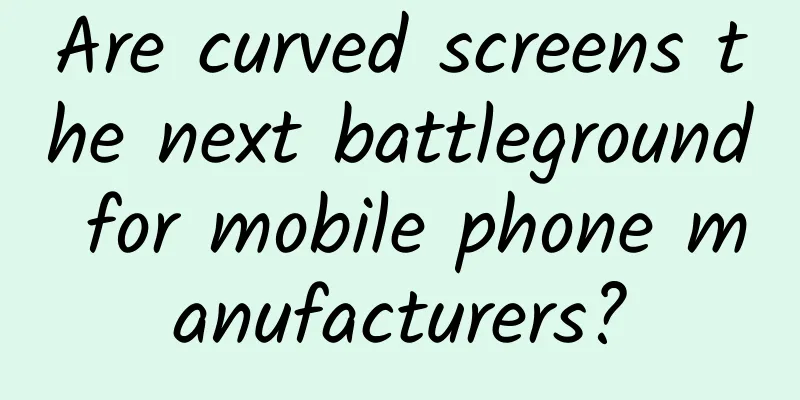Are curved screens the next battleground for mobile phone manufacturers?

|
Curved screens have become a trend in the future of mobile phones and smart TVs. Since last year, Samsung's Galaxy Edge and LG G Flex2 have been representatives of curved screen phones. Earlier, Korean media reported that Xiaomi 5's appearance will copy Samsung's Galaxy Edge phone and will also use curved screen phone technology. The iPhone's current patents also apply for a curved screen patent, which inadvertently shows the future trend of curved screens. Now that Android is becoming more and more homogeneous, it is not easy for mobile phone manufacturers to find a differentiated selling point. Foldable curved screen mobile phones will undoubtedly be a major selling point for mobile phones in the next few years. Let me popularize the OLED technology used in curved screens: OLED display technology has the characteristics of self-luminescence. It uses a very thin organic material coating and a glass substrate. When current passes through, these organic materials will emit light. In addition, the OLED display screen has a large viewing angle and can save electricity. The application direction of OLED on mobile phone screens is firstly thin and light. Within five years, it should have a great impact on LCD TVs, just like the impact of LCD TVs on CRT, plasma and rear-projection TVs. TVs can be made one millimeter thick and can be attached to the wall instead of being hung on the wall. The second direction is the direction of flexible displays. There will be many applications in this direction, such as the integration of mobile phones and wearable devices (currently wearable devices such as watches are difficult to support large screens), such as the retractable display screens in science fiction films, which can all be realized on flexible OLEDs. 1. Advantages of curved screen smartphones: Current curved screens take full advantage of the characteristics of OLEDs, making image reproduction brighter and more vivid, while minimizing glare. Flexible screens are made of special plastics that are more elastic, less prone to breakage, and more resistant to drops than traditional rigid, fragile flat glass surfaces. Nevertheless, the durability of the special materials of OLED screens will be greatly reduced by contact with air and moisture. Traditional glass materials, on the other hand, can adapt well to climate conditions. Therefore, glass materials are considered to be an economical and effective way to solve the durability problem of future "foldable" curved screen phones. In addition, with the guidance of curved screen technology, smartphone processors and other important components may also be "curved" like OLED screens in the future. But before that, in addition to the above-mentioned advantages, another benefit of curved screen smartphones is probably that they fit the contours of the face better when making calls. 2. Disadvantages of curved screen smartphones: Curved screen phones are generally expensive, and there is no cost-effectiveness in either the smartphone or smart TV field. The reason is that the core technology of OLED is generally controlled by LG and Samsung, and it is not an exaggeration to call it a monopoly. The competition in OLED technology is not fierce enough, which allows LG and Samsung to control the price of OLED and determine the high-end price of OLED products. Price is only part of the reason. The practicality of curved screen smartphones is more important. In fact, it is hard to say that the appearance of several curved screen smartphones on the market is good-looking. Some designs are a bit weird, and some are just mediocre. The conservativeness in appearance design is a major factor that people are generally unwilling to accept. Mobile phone manufacturers should use the foldable characteristics of OLED to design several foldable phones, making the phones look a bit futuristic. This is what people want, instead of just designing the phone to be a little curved and people will accept it. Of course, OLED only has the characteristic of being foldable, but the current bottleneck of OLED technology is far from allowing mobile phone manufacturers to fold and use it freely. Can they make the phone into whatever they want? Now let's take a look at the representative curved screen mobile phones that have appeared on the market: LG G Flex2 At this year's CES, LG released the LG Flex 2LG. Compared with the previous generation, it is still symmetrically curved based on the horizontal axis in the middle of the phone, that is, when the screen is in landscape mode, you can watch movies with a curved screen like in a cinema, but it will be greatly reduced on the 5.5-inch G Flex 2. So its more practical effect is that it is more comfortable to hold in the hand, more in line with the sliding of fingers, and more comfortable to make calls, with the feeling of a landline microphone. In addition to the bendable body, the G Flex 2 also inherits the self-healing back cover of the first generation. The first generation product takes about 3 minutes to heal scratches, while the second generation only takes 10 seconds. This is the second selling point of the G Flex 2 besides the bendable screen. As smartphone configurations become increasingly weaker, these selling points become more important. At the same time, its shock resistance and durability have also been improved. The internal design is said to have high elasticity, so the phone is not afraid of breaking when it falls. This is the most obvious effect. LG dual-curved screen mobile phone LG has focused on screen technology in recent years and announced its second-generation curved-screen phone, the G Flex 2, at this year's CES. However, seeing that its fellow competitor Samsung had earlier launched the curved-screen phone Galaxy Note Edge, LG was prompted to announce the original model of the dual-curved phone at this year's CES to "show its quality" to everyone. According to sources, the dual-curved screen mobile phone exhibited by LG this time has a screen size of 6 inches and a resolution of 1280 X 720. The curved surfaces on both sides of the screen can be operated independently. Although the dual-screen mobile phone is attractive enough, the 720P screen resolution seems a bit outdated compared to the 2K resolution of the current mainstream flagship mobile phones, making it difficult for people to accept. Galaxy Note Edge Galaxy Note4 Edge uses a curved screen. Because of the extra side screen, the phone is 3.8mm wider than Note 4, but 2.2mm shorter. Functionally, the side screen can display multiple gadgets, such as ruler, timer, weather, time, and some third-party applications. At the same time, it also has a do not disturb function, and the camera button is also controlled on the curved side screen, which is very convenient. Users can also set the wallpaper of the side screen. How to apply the curved screen is a topic facing all manufacturers. Don't laugh at LG and Samsung, who have the technology but don't know how to use it. Trial and error is a way of innovation with the least risk. When all the application forms are displayed, relatively excellent ideas can be selected. With limited information, I think Samsung doesn't care about the sales of this Galaxy Note Edge at all, but cares about the reputation of "first". Even if a manufacturer launches a more user-friendly curved screen product in the future, it can't avoid the title of a follower. Galaxy Note Edge is the first smartphone to try to use a curved screen to change the interaction of smartphones. Not long ago, foreign media revealed that the iPhone has applied for a foldable patent. This patent application was originally submitted by Apple in September 2011. It seems that Apple has been researching the use of foldable screens for some time. However, since the iPhone 6 has just been released, it is unlikely that Apple will release a new iPhone design in the short term. It seems that Apple will have to wait at least a few more years before launching flexible products. In any case, foldable curved screens are a major direction for the development of future smartphones. Whether it is Apple, Samsung, or LG, they will not be indifferent to this. They will explore endlessly. What should foldable smartphones look like in the future? As a winner of Toutiao's Qingyun Plan and Baijiahao's Bai+ Plan, the 2019 Baidu Digital Author of the Year, the Baijiahao's Most Popular Author in the Technology Field, the 2019 Sogou Technology and Culture Author, and the 2021 Baijiahao Quarterly Influential Creator, he has won many awards, including the 2013 Sohu Best Industry Media Person, the 2015 China New Media Entrepreneurship Competition Beijing Third Place, the 2015 Guangmang Experience Award, the 2015 China New Media Entrepreneurship Competition Finals Third Place, and the 2018 Baidu Dynamic Annual Powerful Celebrity. |
<<: Is the spring for “black taxis” coming?
>>: Can the self-produced talent show help Sohu Video regain its momentum?
Recommend
information! Major update to the Apple Store backend, monitoring of 5 major download data sources is beneficial to developers!
On May 3, Apple made a high-profile announcement ...
The big shell hidden by Tang Monk in Tongtian River in "Journey to the West" is actually a first-class national treasure!
Recently, a giant clam weighing 1.5 kilograms was...
This method is enough to delete useless system software on your phone
The issue of mobile phone privacy and security ha...
Whose nerves were touched by Pechoin’s “high dissemination, low conversion”?
Recently, Pechoin ’s amazing advertisement has se...
4 Steps to Improve User Retention!
For a product, retention rate is the most importa...
Scientists develop insect field monitoring device that preserves high-quality DNA
Have you ever seen a collection device filled wit...
Japan's "Xiang Xiang" and the United States' "Ya Ya" return to China! How difficult is the road to protecting giant pandas?
There were numerous banners, fans were crying wit...
Chen Qingtai: The shortage of raw materials such as cobalt and nickel has become a major risk in the development of new energy vehicles
"The global lithium, cobalt and nickel resou...
Should companies develop WeChat mini-programs?
Should companies develop WeChat mini-programs? Do...
Digging deep into the optimization logic and breakthroughs of the post-bonus period of oCPC
Optimizing oCPC is a necessary and likely long-te...
Google I/O Conference: AI as the protagonist, aiming at VR standards
Google's 2016 I/O Developer Conference was he...
Stock, increment and retention in product operation
In the process of product operation , data or tec...
70% of App promotions are fraudulent. Whose cake has been touched by anti-cheating?
[51CTO.com original article] At present, the mobi...
Renault joins hands with aviation companies to focus on unmanned vehicle simulation testing to accelerate the layout of autonomous driving
French automaker Renault has announced a partners...









